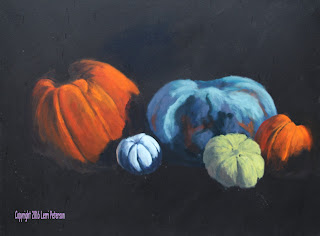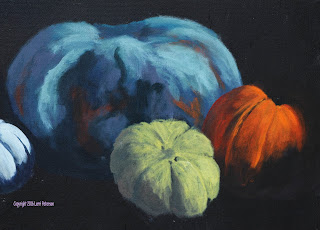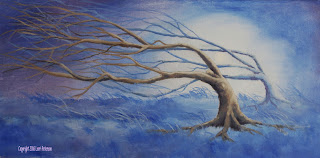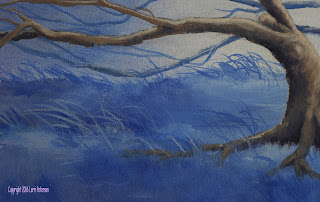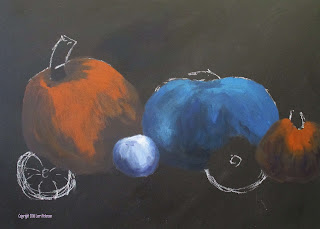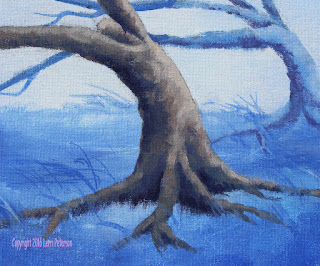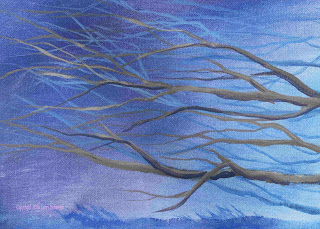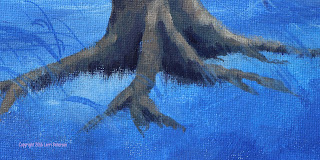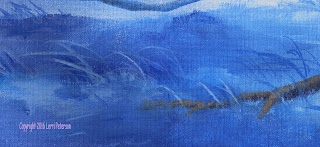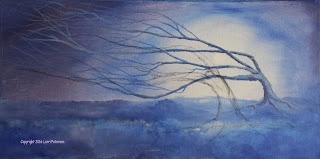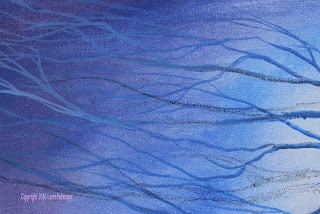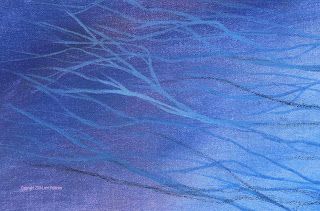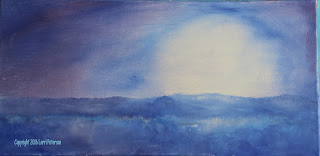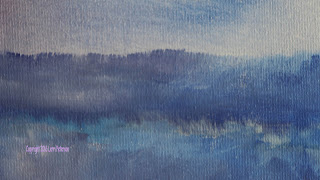Acrylic Class Project: Pumpkins on Parade Week 2
This week I added one of the smaller pumpkins in front and started adding highlights, shadows and some detail.
When you are adding highlights and shadows remember that each segment of the pumpkins is curved so each will have it's own unique shadow pattern.
On the blue pumpkin, I am not worried about the detail just yet, I want to get the highlights and shadows established before I add add that texture. I also added touches of orange to parts of the pumpkin because it is there on the real pumpkin.
I worked on the highlights and shadows of the small orange pumpkin and based in the light yellow fairy pumpkin in front of it. Working wet into wet, I created to bases for the shadows.
Whether I am working on the big pumpkins or the small ones I am always following the shapes and curves of the pumpkin.
Note how each segment is light on one side and has shadows on the other.
I was using my #4 flat bristle brush but you may also want to use a sable brush.
The dark color I used was made up of the darkest colors I have on my palette, so far, the only black I have used is the gesso to make the canvas black.
I will be working a bit faster on this project so you can see how it gets finished, if you can't keep up I will be posting my progress until it is finished. Good luck.
Keep painting and I will see you in class.
Sunday, October 30, 2016
Sunday, October 23, 2016
Fall 2016 Acrylic Class Week 4
Acrylic Class Project: Windblown Final Week
This final week I added more detail by adding more branches and twigs both light and dark and adding more highlight to the tree trunks. I also added more grasses around the bottoms of the trees to seat them into the grass.
Using my flat sable brush I was able to pull up clumps of grasses around the base of the tree and over the roots using the dry brush technique (little paint or water on the brush). I added both light and darker grasses with the dry brush, then I switched to my liner brush and pulled up some longer grasses (light and dark) remembering to bend them to match the bend of the trees to help create the effect of being windblown.
Pumpkins on Parade
I am working on a black canvas this time. I used black gesso on a regular stretched canvas, you can also buy black canvases at the store.
Using white chalk, I sketched in my pumpkins. If I need to change anything I don't like I can take a wet paper towel and wipe it off and redo my sketch.
I was using a #6 flat bristle brush to start the under painting for the pumpkins.
The orange pumpkins were under painted using burnt sienna with a touch of orange in the lighter areas them mixing wet into wet as I moved into the shadowed areas I added ultramarine blue to the sienna and finally in the darker areas I also added the blue with alizarin crimson instead of purple (I was out)
The blue pumpkin I used pthalo blue instead of ultramarine blue, and a little touch of orange to dull it and white to lighten it. then added more pthalo blue and burnt umber (sienna will work) as I moved to the shadows and also a bit of the alizarin. The bumps will come later.
The light small pumpkin was shades of grey blue using my ultramarine blue and sienna to make a gray, more white to make it lighter and more blue and alizarin for the darker colors.
Remember that this is only the under painting, this is where we start and your under painting should be in the mid tone range so you can go darker or lighter as you progress to the finished painting. Do not try to finish as you go or your painting will look flat not round.
This painting is going to go faster this time so I am sure that you have enough information so you can finish it up if we don't have enough time until the end of the semester.
Keep painting and I will see you in class.
This final week I added more detail by adding more branches and twigs both light and dark and adding more highlight to the tree trunks. I also added more grasses around the bottoms of the trees to seat them into the grass.
Using my flat sable brush I was able to pull up clumps of grasses around the base of the tree and over the roots using the dry brush technique (little paint or water on the brush). I added both light and darker grasses with the dry brush, then I switched to my liner brush and pulled up some longer grasses (light and dark) remembering to bend them to match the bend of the trees to help create the effect of being windblown.
Pumpkins on Parade
Using white chalk, I sketched in my pumpkins. If I need to change anything I don't like I can take a wet paper towel and wipe it off and redo my sketch.
I was using a #6 flat bristle brush to start the under painting for the pumpkins.
The orange pumpkins were under painted using burnt sienna with a touch of orange in the lighter areas them mixing wet into wet as I moved into the shadowed areas I added ultramarine blue to the sienna and finally in the darker areas I also added the blue with alizarin crimson instead of purple (I was out)
The blue pumpkin I used pthalo blue instead of ultramarine blue, and a little touch of orange to dull it and white to lighten it. then added more pthalo blue and burnt umber (sienna will work) as I moved to the shadows and also a bit of the alizarin. The bumps will come later.
The light small pumpkin was shades of grey blue using my ultramarine blue and sienna to make a gray, more white to make it lighter and more blue and alizarin for the darker colors.
Remember that this is only the under painting, this is where we start and your under painting should be in the mid tone range so you can go darker or lighter as you progress to the finished painting. Do not try to finish as you go or your painting will look flat not round.
This painting is going to go faster this time so I am sure that you have enough information so you can finish it up if we don't have enough time until the end of the semester.
Keep painting and I will see you in class.
Sunday, October 16, 2016
Fall 2016 Acrylic Class
Acrylic Class Project: Windblown Week 3
I used the wet into wet technique to change the value of my color (lighter add white, darker add more blue and touches of purple), and I made a series of dabbing strokes with my brush to create texture, all the time being aware of the curves and angles of what I was painting.
The smaller thinner branches were done with my liner brush. Be sure to have enough water to make your paint ink-like and add both dark and lighter branches and twigs to your tree.
Around the base of the trunk and roots, you can use either your flat sable or flat bristle brush to pull up some of the shorter grasses to set the tree down into the ground.
Then use your liner brush to add longer grasses. Remember to lean them in the same direction as the tree to give the windblown look to the grasses as well.
I have a bit more work to do on mine, I need more smaller branches and grasses but I may also get started on my next project of the pumpkins. I will have black gesso with me if you want to try working on a black canvas, though a white canvas is fine, you will just have to decide what kind and color you want for your background.
Keep painting and I will see you in class.
Saturday, October 8, 2016
FALL 2016 ACRYLIC CLASS WEEK 2
Acrylic Class Project: Windblown Week 2
This week we added the background tree. I used a #6flat sable brush to block in the trunk and main branches and roots switching to a liner brush for the smaller finer branches and twigs.
I used a medium blue which was a mix of the ultramarine blue and a touch of white.
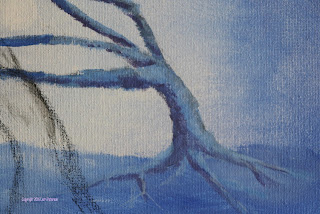 To create shading I added a bit more white to the color, to create shadows I added more blue and a touch of purple or you can use a touch of alizarin crimson. Notice that even the "highlight" area is still darker than the background. I am using the contrast to create a silhouette effect. (the black line are from the sketch for the front tree).
To create shading I added a bit more white to the color, to create shadows I added more blue and a touch of purple or you can use a touch of alizarin crimson. Notice that even the "highlight" area is still darker than the background. I am using the contrast to create a silhouette effect. (the black line are from the sketch for the front tree).
When you switch to the liner brush continue to use that medium blue color while you are in the lighter areas, then when you are moving into the darker areas of the background, add a little white to the color so the branches will stand out against the dark background.
Be sure that you make enough of the smaller branches and twigs when doing both trees and do not be afraid to cross over branches that are already there, it will look more natural in your finished painting.
Remember to practice loading the liner brush - the paint should be like India ink so use enough water - then pressing and lifting the brush to create thicker and thinner branches and twigs. Do this before you go to your painting and make a lot of the finer twigs at the ends of the branches it helps break up the negative space and will make your trees look more natural.
Try to have your painting to this point on Monday, we will start working on the main tree and some of the finishing touches. Keep painting and I will see you in class.
This week we added the background tree. I used a #6flat sable brush to block in the trunk and main branches and roots switching to a liner brush for the smaller finer branches and twigs.
I used a medium blue which was a mix of the ultramarine blue and a touch of white.
 To create shading I added a bit more white to the color, to create shadows I added more blue and a touch of purple or you can use a touch of alizarin crimson. Notice that even the "highlight" area is still darker than the background. I am using the contrast to create a silhouette effect. (the black line are from the sketch for the front tree).
To create shading I added a bit more white to the color, to create shadows I added more blue and a touch of purple or you can use a touch of alizarin crimson. Notice that even the "highlight" area is still darker than the background. I am using the contrast to create a silhouette effect. (the black line are from the sketch for the front tree).When you switch to the liner brush continue to use that medium blue color while you are in the lighter areas, then when you are moving into the darker areas of the background, add a little white to the color so the branches will stand out against the dark background.
Be sure that you make enough of the smaller branches and twigs when doing both trees and do not be afraid to cross over branches that are already there, it will look more natural in your finished painting.
Remember to practice loading the liner brush - the paint should be like India ink so use enough water - then pressing and lifting the brush to create thicker and thinner branches and twigs. Do this before you go to your painting and make a lot of the finer twigs at the ends of the branches it helps break up the negative space and will make your trees look more natural.
Try to have your painting to this point on Monday, we will start working on the main tree and some of the finishing touches. Keep painting and I will see you in class.
Sunday, October 2, 2016
Fall 2016 Acrylic Class Week 1
FALL 2016 ACRYLIC CLASS PROJECT: Windblown Week
1
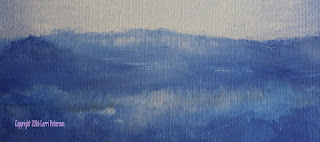 The top edges of these layers do not need to be
perfectly even, these are supposed to be grasses or uneven terrain, so while it
might basically be flat it doesn't need to be perfect.
The top edges of these layers do not need to be
perfectly even, these are supposed to be grasses or uneven terrain, so while it
might basically be flat it doesn't need to be perfect.
I am working on a12 by 24 inch canvas, basically
it is twice as long as it is tall. I am using a longer canvas to emphasize the
image I will put on my canvas. If you have a more rectangle size canvas this
will still work through your sky area will probably be larger so you will need
to add something to your sky to make it more interesting like a sun or moon,
you still want the trees to be the dominant focus of your painting.
This project can be any combination of colors
that you want if you have someplace you think you might want to hang it you can
match the color theme of the room, this is the beauty of this painting is that
when you change the color it changes the mood of the painting, this is a fun
thing to do.
I saw these trees down in front of the Redondo
Beach Library in Veterans Park near the pier and I really liked their shape but
I didn't like what was around and behind them but I'm an artist so I get to do
whatever I want and I decided to just use the trees as inspiration and to
create my own work of art from them.
You as an artist need to learn how to do this.
Too often I find students bring in photos that have a lovely subject with a
horrible background and what do they do they spend all their time sweating over?
Creating this horrible background that their lovely subject gets lost in then
they aren’t happy with the results. If you look at the photo of the trees that
I took, you can see all kinds of unimportant stuff in the photo. There are
apartment buildings, there are park benches and trash cans and who knows what
else that do not need to be a part of my painting. I tell my students that as
artists we are the ultimate in Photoshop we have an artistic license and we
need to use it and this subject is a prime example.
During this painting we are going to be using a
couple of brushes that we don't normally use, 1 will be are blending brush that
is the 2-inch soft bristle brush that we use for covering large areas. With
this brush you can make some very soft blended backgrounds so it is good
practice to use this. That said I think that you will find that it is not as
easy as I make it look just remember that I have been doing this for about 30
years so I kind of know what I am doing, you will need to practice.
The other brush we will be using will be the
liner brush or script liner brush. With this little brush we can make some amazing
trees and grasses, again I will make it look easy you will need to practice, I
do suggest that you find an old canvas or even a piece of paper that you can
paint out and practice these two techniques for this painting before you start
working on your painting.
The first thing I did to my canvas was too wet
the surface, I use my spray bottle and then I used my big blending brush to
evenly coat the surface of my canvas with the water. This will help when I
apply the gesso which is next. Using the gesso I put a thin, even coat over the
entire canvas. Using the gesso in this way lets me blend my colors and it also
dries slower than the acrylic paint giving me more blending time, the water I
sprayed on will also help increase the blending time which you will need for
this stage. You must work quickly this is not going to be a half an hour
project that should only take you 5 minutes or little more to complete most of
you will fail at that but that's your goal because you need to have the paint
still workable throughout this process so that you can blend your colors.
I picked up a tiny amount of ultramarine blue
and a little bit more gesso, starting in the right hand third of my canvas I
started adding this blue and gesso in a circular fashion with criss cross strokes
blending outward to form a circle of a very light blue. I want the color to be
a very pale blue in this area because this is where my trees will be.
Next I picked up some more ultramarine blue with
a little bit of white and just on the outside of this pale blue area I just
painted, I applied the next layer of color blending it all the way around the
outside of the light area and about to the half way point of the canvas,
remember, I am working very quickly. Next I again go to the ultramarine blue
but this time I add a little bit of purple but no white this time, be
sure that it is more blue than purple, again I start just outside the layer
that I had just put on and added this new color working it all the way to the
corners, you can add blue and little touches of purple as you go to make the
color dark.
Then I rinsed my brush out good, it needs to be
clean for this next step also squeegeed out all of the excess water so that it
was damp but not dripping wet. You may want to lightly mist the canvas at this
point before you start blending to give you a bit more time, remember that you
need to work quickly and work this extra moisture in or it will cause spots. Starting
in the light area with crisscross strokes and a very light touch, I blended my
colors, blending the light color out into the next color and working my way
around until one blended into the other and the lines disappeared, then working
out through the next band of color and out to the darkest band of color. You
may need to mist with a little bit of water if your paint feels dry, your brush
will drag if it is too dry, and it won't blend, take you're mister bottle and
lightly mist with two or three squirts of the bottle of water then quickly work
and blend them in with your blending brush, this will give you more blending
time you want to make sure that you do blend this spray in or it will cause
polka dots on your canvas.
You will find that you may be leaving brush
marks as you are trying to blend, this will happen when your brush is 1, too
perpendicular to the canvas, the brush needs to be almost parallel with the
canvas surface as you paint and 2, you may be using too much pressure on your
brush, as the late Bob Ross used to say: “It's two hairs and some air” you're
barely skimming the surface of your canvas very lightly blending these areas
together. It does take practice, however, once you have mastered this you can
create some wonderful backgrounds for all sorts of projects: it can become tall
grasses off in the distance, it could be a soft blended background for a
portrait, it could look like out of focus leaves for flowers… the choice will
be yours and it will make a wonderful addition to your artist’s skill set.
Once you have blended across you can start on
the foreground which is divided into two separate bands, the bands will be of a
medium blue color or a medium color of whatever color scheme you have chosen.
You can do this while the background is still wet or wait until it dries as I
have done.
I switched from my blending brush - though I
could have used it as well - instead I used my number 10 flat sable brush to
block in the first layer of ground which will be the background layer starting with
this medium color, using the whole edge of my brush and pulling down to create
my top edge of my background. I added more blue and purple as I went down the
canvas to create a darker color and right under the lighter area I added a little
bit of gesso to make the blue a little lighter. I am doing this so when I put
the next layer on I will have dark behind the top edge of the new layer so that
I can use is contrast by using a lighter color against the darker color.
 The top edges of these layers do not need to be
perfectly even, these are supposed to be grasses or uneven terrain, so while it
might basically be flat it doesn't need to be perfect.
The top edges of these layers do not need to be
perfectly even, these are supposed to be grasses or uneven terrain, so while it
might basically be flat it doesn't need to be perfect.
This is where stopped for the day, please try to
have your paintings to this point when we meet again. Remember, I've had 40
years of practice and you're just getting started so it may take you more than
once to get this done to you liking, keep painting and I will see you in class.
Subscribe to:
Posts (Atom)
